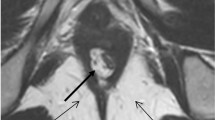Abstract
In spite of the progress in the field of surgical treatment of anorectal malformations, faecal incontinence is, in variable degrees, still an unpleasant and frequent postoperative sequela. Postoperative CT demonstrate the location of the pulled-through intestine, including whether it had been correctly placed through the levator ani and in the spincteric muscular complex. In our nine patients we discovered a correlation between the CT findings and the clinical picture. The cases of incontinence whether associated with sacral anomalies or not were characterized either by marked hypoplasia of musculature or by the pull-through having missed the sphincteric musculature. CT scans could be of use in planning further surgery.
Similar content being viewed by others
References
Stephens FD, Smith ED (1971) Anorectal malformations in children. Year Book Medical Publishers, Chicago
Soave F (1969) Surgery of rectal anomalies with preservation of the relationship between the colonic muscular sleeve and puborectalis muscle. J Pediatr Surg 4: 705
Rehbein F (1967) Imperforate anus; experiences with abdomino-perineal pullthrough procedures. J Pediatr Surg 2: 99
Romualdi P (1960) Eine neue Operationstechnik für die Behandlung einiger Rectummissbildungen. Langenbecks Arch Chir 296: 371
McGovern B, Trump DS (1969) Localization of the external sphincter during operation for imperforate anus. Surgery 66: 1090
Swenson O, Donnellan WL (1967) Preservation of the puborectalis sling in imperforate anus repair. Surg Clin North Am 47: 173
Romualdi P (1961) Treatment of some particular difficult cases of anus prostaticus. Riv Chir Pediatr 3: 1
Freeman NV, Bulut M (1986) “High” anorectal anomalies treated by early (neonatal) operation. J Pediatr Surg 21: 218
Ikawa H, Yokoyama J, Sanbonmatsu T, Hagane K, Endo M, Katatsumata K, Kohda E (1985) The use of computerized tomography to evaluate anorectal anomalies. J Pediatr Surg 20: 640
Kohda E, Fujioka M, Ikawa H, Yokoyama J (1985) Congenital anorectal anomaly: CT evaluation. Radiology 157: 349
Pena A, De Vries PA (1982) Posterior sagittal anorectoplasty: important technical considerations and new applications. J Pediatr Surg 17: 1976
Holschneider AM, Poschel J, Kraeft H, Hecker W Ch (1979) Pickrell's Gracilis muscle transplantation and its effects on anorectal continence. A five year prospective study. Z Kinderchir 27: 135
Kiesewetter WB, Jefferies MR (1981) Secondary anorectal surgery for the missed puborectalis muscle. J Pediatr Surg 16: 921
Mezzacappa PM, Price AP, Haller JO, Kassner EG, Hansbrough F (1987) Demonstration of levator sling in congenital anorectal anomalies. J Comput Assist Tomogr 11: 273
Author information
Authors and Affiliations
Rights and permissions
About this article
Cite this article
Taccone, A., Martucciello, G., Fondelli, P. et al. CT of anorectal malformation — a postoperative evaluation. Pediatr Radiol 19, 375–378 (1989). https://doi.org/10.1007/BF02387631
Received:
Accepted:
Issue Date:
DOI: https://doi.org/10.1007/BF02387631




